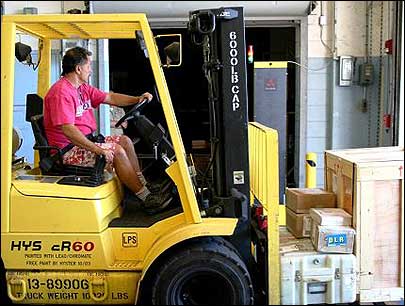The Navy Automatic Identification Technology (AIT) program, implemented by the U.S. Navy, has deployed an RFID system to track supplies and equipment as they pass through naval base warehouses in Pearl Harbor, as well as the warehouse operated by Marine Air Logistic Squadron 24 at the Kaneohe Bay Marine Corps Base, both on the Hawaiian island of Oahu. The system, deployed in June of this year, is expected to improve the Navy’s and Marine Corps’ asset visibility as materiel is transported both onto and off of the island.
GlobeRanger is providing software, middleware and integration for the system. Washington, D.C., supply chain management consultant XIO Strategies provided program management, with Alien Technology and Psion Teklogix supplying hardware.

The two Oahu bases receive and ship materiel destined for troops or other bases, or broken equipment that need to be shipped to the mainland for repair. In either case, the Defense Logistics Agency (DLA) is now tagging those items with Alien EPC Gen 2 passive UHF RFID tags at its Pearl Harbor location. The tags are scanned and linked to a product number associated with data about the item in a variety of Naval legacy systems.
Without the RFID tracking system, says Michael Bigbee, GlobeRanger’s senior VP of sales, the Navy had little visibility into the locations of assets as they were moved through or stored in warehouses. Although active RFID tags are often placed on containers for overseas shipping, and scanned at port locations, it’s the other stops along the supply chain that are hard to track, he says. With real-time data regarding an asset’s location, military personnel in Oahu are able to avoid ordering extra, unnecessary “just in case” assets. The Navy now has increased visibility into when an item is shipped, what time it is expected to arrive at its next location or its whereabouts if it is delayed.
The Navy brought this problem to GlobeRanger in early 2008. The greatest challenge for the company was data management, which the Navy currently manages on a variety of legacy systems employed by various bases and military branches. As the Navy switches to an SAP ERP system (the transition is expected to be completed sometime between 2015 and 2017), the agency required an RFID solution that could work with the various existing legacy systems and easily shift to the SAP ERP software. In the case of the Marine Corps, the systems will switch to Oracle‘s ERP software.
GlobeRanger designed a system that will work for the legacy management systems now in use, and could easily be transferred to SAP. XIO Strategies provided program management to coordinate the various systems to which data would be transmitted. GlobeRanger’s iMotion edgeware manages the interrogators, and the GlobeRanger middleware enables the translation of read event data to the military’s legacy back-end systems. “That was the biggest challenge for this application,” Bigbee says.
When an item arrives at the DLA depot in Pearl Harbor—whether intended for the Marine Corps or for the Navy—it is tagged with an Alien RFID tag, then scanned and linked to information about that item. As the item enters or exits a dock door at the DLA facility, or at the Navy’s warehouse in Pearl Harbor or the Marine Corps’ Kaneohe Bay warehouse, an Alien RFID portal reads its tag. The interrogators at the DLA site had already been installed in a previous deployment, Bigbee says. GlobeRanger has installed an RFID portal at the Marine Corps warehouse, as well as at each of three Navy warehouses at Pearl Harbor.
Data from each read is captured by the fixed interrogators and transmitted via a cabled connection to the Navy and (when applicable) Marine Corps back-end systems. When a driver picks up a tagged item, he employs a Psion Teklogix handheld computer with a built-in RFID interrogator to scan the tag once more, indicating the item has not only left the dock doors, but been picked up by the driver. Upon delivering the item to another base, the driver again scans the RFID tag. This is useful in situations in which items are not immediately brought in through dock doors, or when they are too large to fit through them.
The military can utilize the data from RFID reads not only to locate items, but also to conduct such business analytics as tracking transportation time, or to receive or send notices when items are delivered.
The Navy provided four days of classroom instruction for warehouse employees to explain how the system works, and the staff also received hands-on training in the warehouse. The Navy intends to continue deployment of the GlobeRanger system at other Navy and Marine Corps locations as well, though the sites being targeted have not yet been specified.


